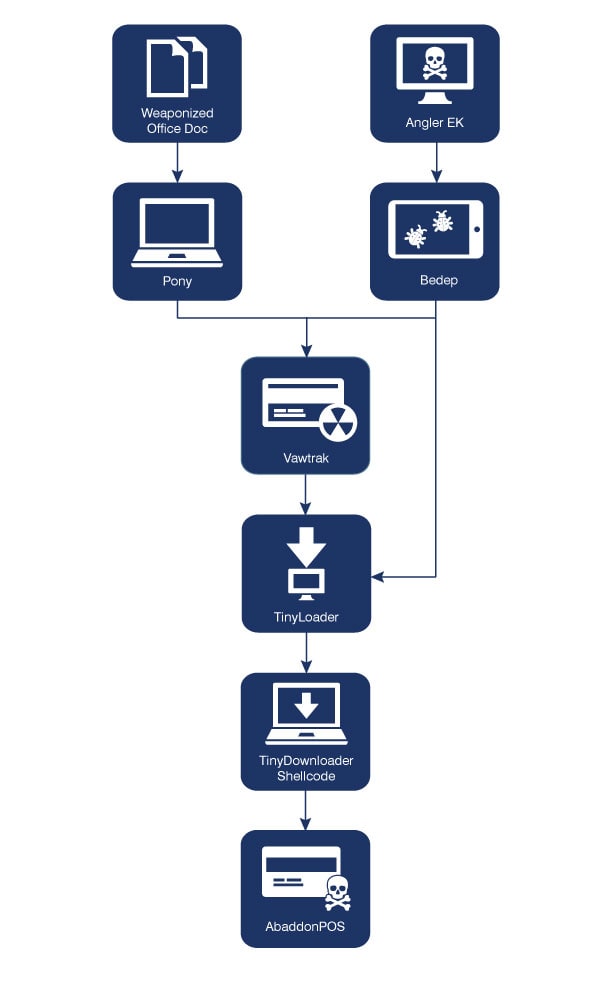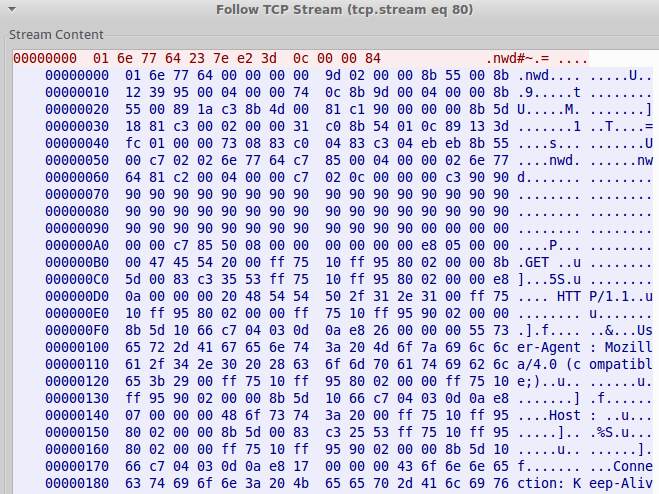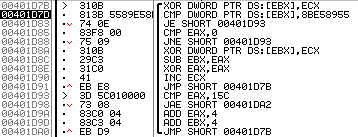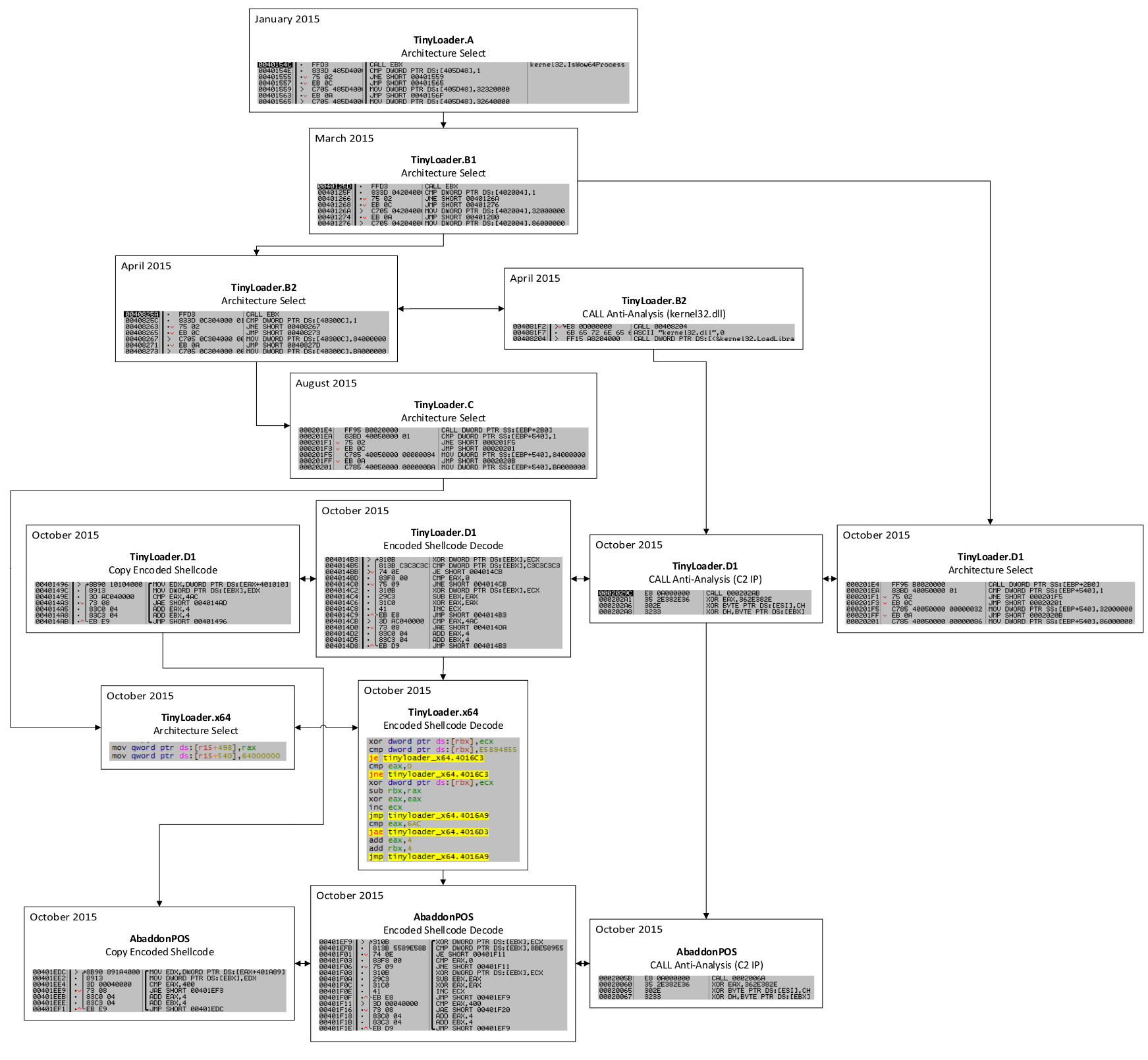UPDATED 11/24/2015
Point of sale (PoS) malware has been implicated in some of the biggest recent data breaches, striking retailers, restaurants, hospitality and organizations from a variety of industries, and often targeting consumers in the US. [1] Once considered too difficult to carry out to be practical for cybercriminals, the retail breaches of late 2013 demonstrated that these attacks are both feasible and highly profitable for cybercriminals, and PoS malware has since continued to evolve and grow in both variety and sophistication. [2]
Proofpoint threat researchers recently detected a new addition to PoS malware landscape. Named AbaddonPOS by Proofpoint researchers, this sample was initially discovered as it was being downloaded in the process of a Vawtrak infection. This use of additional payloads to enhance attack capabilities offers another example of efforts by threat actors to expand their target surfaces through the delivery of multiple payloads in a single campaign, in this case by including potential PoS terminals. This post will analyze AbaddonPOS; discuss the observed infection vectors; and expose, details on the downloader used to retrieve this new PoS malware. We will also provide evidence to demonstrate that the downloader malware and PoS malware are closely related, perhaps even written by the same actor or actors.
Known infection vectors
On October 8, Proofpoint researchers observed Vawtrak [3] (project ID 5) downloading TinyLoader, a downloader that uses a custom protocol for downloading executable payloads from its command and control (C2) server. TinyLoader was then used to download another downloader in the form of shellcode, which then downloaded AbaddonPOS. Although this infection vector was initially specific to Vawtrak’s project ID 5, we have also since observed it delivered in project IDs 6, 9, 10, 12, and 13. The project ID’s are most easily observed with Vawtrak C2 traffic, as they are stored encoded in the PHPSESSID cookie value. Using the cookie value we provided as an example in our research on Vawtrak enables us to see it in a decoded state (Fig. 1). Bytes 4-7 contain the project ID in little-endian byte order.

Figure 1: Decoded Vawtrak cookie displaying campaign/project ID
In addition to observing AbaddonPOS as it was delivered by an Angler EK → Bedep → Vawtrak infection (Cyphort, [4]) and Angler EK → Bedep (bypassing Vawtrak), Proofpoint researchers have also observed this infection behavior delivered by weaponized Microsoft® Office documents downloading Pony → Vawtrak (Fig. 2).

Figure 2: AbaddonPOS infection chain
TinyLoader
TinyLoader’s sole purpose in this infection chain is to retrieve executable instructions from the C2, which allows the attackers to execute their own custom shellcode on infected machines in addition to downloading and executing additional malware payloads. True to its name, TinyLoader is typically 2-5KB in size. One notable characteristic of TinyLoader is that prior to contacting its single hardcoded C2 IP address, the malware will first check to see if it is running as an x64 or x86 process using the IsWow64Process Windows API (Fig 3.). TinyLoader selects a value based on the result of this API call, and the result is then used to tell the C2 which executable code should be downloaded to the infected client.

Figure 3: TinyLoader API call checking for x86 or x64
As shown in Figure 3 above, 0x84 is used with x86 processes while 0xBA is used with x64 processes; however, the values used for each architecture vary depending on the variant. Once the correct architecture is selected, TinyLoader builds a packet to send to the C2 to initiate the payload download process. Prior to retrieving the downloader that downloads AbaddonPOS, we have observed TinyLoader first retrieve a copy of itself (this step may vary slightly), which is then used as a persistence method by adding a registry key to HKLM\SOFTWARE\Microsoft\Windows\CurrentVersion\Run (Fig. 4). TinyLoader may also download a DLL version of itself, in which case the registry key observed is similar to the following: regsvr32.exe /s “C:\PROGRA~2\[a-zA-Z0-9]+\.dll”

Figure 4: Example of TinyLoader persistence registry key
Once the persistent payload is written to disk, another payload is downloaded by TinyLoader in the form of shellcode (Fig. 5), the purpose of which is to manually craft a HTTP request that is then used to download an AbaddonPOS payload (Fig. 6).

Figure 5: TinyLoader binary protocol retrieving shellcode

Figure 6: HTTP request retrieving AbaddonPOS variant, crafted by shellcode
AbaddonPOS
AbaddonPOS is another addition to the PoS malware category, which has attracted a significant amount of attention from malware authors over the years. [4] Similar to TinyLoader, AbaddonPOS is a relatively small package, with most samples being 5KB in size. While the core functionality of this new addition is fairly simple, it contains several features that merit analysis and further discussion: anti-analysis, code obfuscation, persistence, locating credit card data, and a custom protocol for exfiltrating data.
Anti-analysis and obfuscation
AbaddonPOS implements several basic anti-analysis and obfuscation techniques to hinder manual and automated analysis techniques. For example, AbaddonPOS employs a CALL instruction to push a function parameter onto the stack rather than simply using, for instance, the more common PUSH instruction. A CALL instruction pushes the next address onto the stack, which is typically used as a return address following a RETN instruction. In this case, the CALL instruction is used to push the address containing a string (Fig. 7): specifically, the address containing the string “devil_host” is pushed onto the stack, which is then used as a mutex.

Figure 7: AbaddonPOS using CALL instruction to hinder static analysis
Most of AbaddonPOS’ code is not obfuscated or packed, with the exception of the code used to encode and transmit stolen credit card data. This shellcode is encoded using a 4-byte XOR key; however the key is not hardcoded. Instead, using the first 4-bytes of the decoded shellcode, the malware iterates over all possible 4-byte XOR keys until the correct one is found by checking the result against the hardcoded instructions: 0x5589E58B (Fig. 8). Once the XOR result matches the hardcoded instructions, then the correct key has been found and the malware continues to decode the shellcode using that key.

Figure 8: AbaddonPOS shellcode decoding routine
Locating credit card data
AbaddonPOS searches for credit cards by reading the memory of all processes except itself by first blacklisting its own PID using the GetCurrentProcessId API. To find credit card data, AbaddonPOS roughly follows this process:
- Search for 3, 4, 5, or 6 string characters, indicating the first number of a potential credit card
- Credit card number length >= 13 and <= 19
- Valid track delimiter (track 1: “^”, track 2: “=”, or “D”)
- Track 1 max length: 120, Track 2 max length: 60
- Additional checks based on whether track 1 or track 2 delimiters were found
- Check credit card number with the Luhn algorithm
The AbaddonPOS sample with md5 hash: f63e0a7ca8349e02342c502157ec485d was analyzed for the process above. The slightly older version of AbaddonPOS may contain slightly modified functionality, including not allowing “D” as a track 2 delimiter.
Exfiltrating stolen credit card data
Although many of the different PoS malware families rely on HTTP to exfiltrate data, AbaddonPOS uses a custom binary protocol. Communication and exfiltration of credit card data is carried out by the decoded shellcode discussed above. A single hardcoded IP address is used as the C2 address, as well as the encoding routine that is used to obfuscate exfiltrated data. An example of the network traffic generated during a single credit card data exfiltration attempt is shown in Figure 9.As a result of this analysis, Proofpoint created and published ET Pro IDPS signatures (ID’s 2814677-2814680) to detect exfiltration attempts on October 30.

Figure 9: AbaddonPOS exfiltrating encoded credit card data to C2
The first four bytes of the network traffic are the length of the encoded data, while the following four bytes are the value of the process handle returned by OpenProcess. The subsequent bytes are the encoded exfiltrated data, which in a decoded state follows this format:
[credit card data] ***[process name]
To encode the data, the malware first XORs four bytes of the plaintext with the process handle, followed by a second XOR with a hardcoded 4-byte key. The exfiltration network traffic in Figure 9 is shown in its plaintext state in Figure 10.

Figure 10: Plaintext exfiltrated credit card data and process name
The following Python script can be used to decode the network traffic, provided it has been encoded using the technique described above:
import sys,struct,hexdump
filename = sys.argv[1]
with open(filename, 'rb') as f:
c2_traffic = f.read()
encoded_size = struct.unpack('<I',c2_traffic[:4])[0]
openprocess_handle = c2_traffic[4:8]
encoded = c2_traffic[8:]
key = [0x22,0x11,0xAA,0xFF]
decoded = ''
for i in range(encoded_size):
decoded += chr((ord(encoded[i])^key[i%4])^ord(openprocess_handle[i%4]))
print 'Decoded AbaddonPOS exfiltration network traffic:'
hexdump.hexdump(decoded)
AbaddonPOS Variations
Of the samples Proofpoint researchers have discovered and analyzed so far, very few samples seem to have had any functionality added or removed. While “devil_host” is the most prominent mutex used by this malware, we have also found a sample that uses “devil_kor” (md5, a55843235cd8e36c7e254c5c05662a5b), and another that uses “DeviL_Task” (md5, ac03e0e9f70136adede78872e45f6182). We also observed a slightly updated version of AbaddonPOS (see IOCs) where almost all functionality was relocated to the encoded shellcode. In these updated samples the mutex “MG_REX” was used and the credit card search algorithm was also modified by adding ‘D’ as a valid track 2 delimiter.
Connecting the dots
TinyLoader has now been in development for at least a year, with a first sighting reported on January 16, 2015. Over the past year, TinyLoader has undergone several developmental changes, including:
- Switching from UDP protocol to TCP
- Removing process and UUID reporting
- Adding different anti-analysis
- Adding obfuscation and encoding
With the emergence of AbaddonPOS, it was quickly apparent that TinyLoader and AbaddonPOS are closely connected, and not simply because TinyLoader was used as the downloader. The code of TinyLoader and AbaddonPOS share some important similarities, including:
- Anti-analysis (CALL to push strings onto stack)
- Obfuscation (encoding shellcode using exact same encoding routine)
The similarities with code excerpts including a timeline according to Proofpoint data are provided below (Fig. 11).
Figure 11: Code history comparison for TinyLoader and AbaddonPOS
Conclusion
The practice of threat actors to increase their target surfaces by leveraging a single campaign to deliver multiple payloads is by now a well-established practice. While using this technique to deliver point of sale malware is less common, the approach of the US holiday shopping season gives cybercriminals ample reason to maximize the return on their campaigns by distributing a new, powerful PoS malware that can capture the credit and debit card transactions of holiday shoppers.
UPDATE November 24, 2015
Further research on TinyLoader and AbaddonPOS turned up samples indicating that this threat has been in the wild since at least August 2015. The current earliest known samples of AbaddonPOS include:
266ce6d907a90e83da0083eee06af123 -> svchost_bin -> 50.7.138.138:13131 -> Compilation timestamp 2015-08-19 22:29:46
91992a1cac7f15e899b22d9a53cabf71 -> svchost_bin -> 50.7.124.172:13131
538482356b4eb4e0552d16b08d5c2908 -> svchost_bin -> 50.7.124.172:13131
05134cd6a50440b2c6d9ef62d2c2c3a3 -> svchost_bin -> 50.7.124.172:13131
7b137055fd40c39bdc76d27ff4fc82ed -> 50.7.124.172:15151 -> Location: [hxxp://50.7.71[.]99/970/ad06b6e922623e436c7a.exe], downloaded by TinyLoader.C (md5: 4aa0ca129358b82a285e0d069a36e7fb)
7e49d646cb74718dcce21d3d3ad948d1 -> svchost_bin -> 50.7.124.172:14141 -> Location: [hxxp://50.7.71[.]99/upload/7e49d646cb.exe], downloaded by TinyLoader.C (md5: 3733bb7a96e3091183d80b7a4914c830)
c7db01ba6b73188640e0fb65aab0d535 -> svchost_bin -> 50.7.124.172:15151
The earliest versions of AbaddonPOS are distinguished primarily by fact that it first targets track data delimiters ("=" and "^") for finding potential credit card data instead of a beginning number ("3", "4", "5", and "6").
Three earlier versions of AbaddonPOS have been identified (credit: Nick Hoffman):
81055d3e6ab2f349f334a87b090041dc -> svchost_bin -> 50.7.138[.]138:13030
da0cd8228745081b58594103163d22b8 -> svchost_sin -> 50.7.138[.]138:13030
04b68e4f4c7583201397d6674a3e2503 -> svchost_ghost -> 50.7.138[.]138:14040
The primary difference between these versions and the AbaddonPOS version analyzed in the original post is that these other versions contain a process blacklist: these processes will not be scanned for credit card data. The implementation is unique in that it searches only the first four bytes of each process; if those four bytes match, then it will search two more; and if those match as well, that process will be skipped. (Fig. 12) The blacklist contained the following partial process names:
svchso
iexplo
smss.e
csrss.
winlog
lsass.
spools
alg.ex
firefo
chrome
winini
steam.
skype.
dwm.ex.

Figure 12: AbaddonPOS svchost.exe blacklist instructions
Proofpoint researchers discovered the following additional hashes for AbaddonPOS:
4a85feef07d4aed664624331cdbcdd66 -> DeviL_TasK -> 5.8.60[.]23:21920
6ac78bc0bd16273c654cec105567c73e -> no startup mutex -> 5.8.60[.]23:21930
6b02efef0580dce8e49d27196cff6825 -> M_RAY -> 193.28.179[.]13:20930
6f1d8ca36190668163f005c7f2c9007f -> M_RAY -> 193.28.179[.]13:20950
421dfc4856262445d12fe110bf4f2c56 -> DeviL_TasK -> 5.8.60[.]23:21940
9646e0a87be71c225f2aa8639354bd4f -> M_RAY -> 193.28.179[.]13:20940
46810f106dbaaff5c3c701c71aa16ee9 -> no startup mutex -> 176.114.0[.]165:21940
e9aeb88d393e6259b5fb520bc7a49ac0 -> M_REX -> 193.28.179[.]105:20910
Other malware that are likely used by these actor(s) include:
TinyLoader.C (md5: aa7897623f64576586e4b6ec99d8ccc6) was used to download Fleercivet/Bagsu, a Trojan used to commit adfraud (md5: 79dc1ce122f7bddd730d886df1a4739a, location: [hxxp://50.7.71[.]99/file/bin86crypt_full.exe])
TinyLoader.B (md5: a94c51c5e316d6e3b1cde1f80f99eb94) downloaded Fleercivet (md5: 637b764c78ddda0e1d5351a10b19bcb8, location: [hxxp://50.7.71[.]214/upload/7777.exe])
TinyLoader.C (md5: 739cea68598ae347fae1d983e16a7d27) downloaded ReactorBot/Rovnix (md5: c755c9532c1ee517b25f98719968e154 and md5: 9a2fb9aa94d78313420c4106108b5fef, location: [hxxp://80.79.123[.]98/aurum/c.work.exe]
TinyLoader.C (md5: 19516ab9a7169c53bd811c975d5fea7d) was used to download Fleercivet (md5: 227e6b1f3e66f00a4fc683d4f39da904, location: [hxxp://50.7.143[.]61/id_1123.exe]) and a packed TinyLoader.C (md5: a86b91fda7ec634e44e4b6b7e69ed659, location: [hxxp://50.7.143[.]61/40930.exe] )
These actors may have also employed CryptoWall at some point, as the imphash for 227e6b1f3e66f00a4fc683d4f39da904 matches the imphash for a known CryptoWall sample (md5: 2af149845f4d1ce8e712622d3f1ec46e). Both samples are packed, so it is possible that two actors utilized the same packer/crypter or packing/crypting service.
References
[3] https://www.proofpoint.com/us/threat-insight/post/In-The-Shadows
Indicators of Compromise (IOCs)
IDS/IPS Detection (ET signature IDs)
TinyLoader:
2020150-2020153,2020849-2020852,2812523,2812524,2814778,2814779,2814803
TinyDownloader (downloader shellcode HTTP request):
2814810
AbaddonPOS:
2814677-2814680
TinyLoader Samples:
0c77886a3ea42b75fcd860d4d97e72c5
a3ea1a008619687bdfef08d2af83f548
a53d8212a47bf25eeca87c1e27042686
a7a666ab9548fd1f0a8eb8050d8ca483
a9cc6736e573ad9e77359062e88114e2
aaac35389c9be79c67c4f5c4c630e5d5
b3a057f55a8fa2aad5b8d212a42b4a88
bcf271e83c964eb1fd89e6f1a7b7a62f
c42f20e2a68b8829b52b8399b7b33bf2
d785592932323f6ddaa121bcdcbceba0
e08aeb0bfcbae33b851af9f8be413111
e92254f9ce7d6f45e907e77de146ef37
ec322598eec364a755b5aea70d2a2da8
1c02f2f3fa15cc6a472119389d25983e
1c2a757c63ee418135e89cc8ef0d6e63
2b3704e0acbcbc265d0d08502a9bf373
3a7ac0c907b2c406ab480d4ed2f18161
3f71031ce8ecb0f48847ccb8be86a5fe
4b86cbb2e9f195bef3770d877206068d
6ee164908a94a881032d0649e2bd2505
6f7fabeb9ce76a1d52dbf5a40cbc74e8
7b7ffdd46d1f7ccea146fd9d5a2412ae
7c69dc17977b3431ff15c1ae5927ed0d
7eddbf17a3d1e398621194b0f22402a7
8d6d7a7d77215370d733bda57ef029f4
8df542e35225e0708cd2b3fe5e18ac79
9b340ac013c052ffb2beb29d26009a24
47e5c290f3f443cca027aa344cbf194f
54f1cda856ae921846e27f6d7cc3d795
77f124332a17b3ef6c0b6a799ad0c888
89a19ccb91977d8b1a020f580083d014
9320175f8af07503a2b2eb4d057bac07
885829081f91c6baf458166c3f42e281
a1d1ba04f3cb2cc6372b5986fadb1b9f
TinyLoader C2 IP addresses:
91.234.34[.]44
50.7.138[.]138
149.154.64[.]167
5.8.60[.]23
176.114.0[.]165
AbaddonPOS Samples:
5bf979f90307bac11d13be3031e4c6f9
a168fef5d5a3851383946814f15d96a7
a55843235cd8e36c7e254c5c05662a5b
1c19494385cb21b7e18252b5abd104f6
2b58f7cb4df18509a743226064b30675
752dcae6eb492263608a06489546098f
976275965fcf19a98da824b1959500c1
227e6b1f3e66f00a4fc683d4f39da904
8ca1278e2821fd2dd19c28725f754577
ac03e0e9f70136adede78872e45f6182
12cd4df2264624578919596371edee81
317f9c57f7983e2608d5b2f00db954ff
f63e0a7ca8349e02342c502157ec485d
0900582ba65c70a421b5d21d4ed21f16
4b0db5398f02dae5315f0baff1475807
703f492b2624899ec47b929f65265bbb
5e33b1273b2e2d4cd0986b9873ab4bc4
d11c4a4f76b2bea502b80229a83c30bc
e50edb61e796c6ead88cac53719e2d00
dc1a975e20eca705c6c78dc24f1290b5
6a6977ea317f0240a3dacc0753257518
5e06563f6303eab10c3cd46f0fd5c2d6
7ef654cdc7c2b54772400e26eb292caf
946be7ddd511ff9f49b5073896346eab
AbaddonPOS Exfiltration C2 IP addresses:
5.8.60[.]23:21910
5.8.60[.]23:21930
50.7.138[.]138:13030
50.7.138[.]138:15050
91.234.34[.]44:20940
91.234.34[.]44:20970
149.154.64[.]167:20910
149.154.64[.]167:20920
149.154.64[.]167:20940
149.154.64[.]167:20940
176.114.0[.]165:20910
176.114.0[.]165:21910
176.114.0[.]165:21940
Observed AbaddonPOS Location URLs:
[hxxp://50.7.143[.]61/f_p/f_940.exe]
[hxxp://50.7.143[.]61/n_p/n_940.exe]
[hxxp://50.7.143[.]61/kor_up.exe]
[hxxp://50.7.143[.]61/f_p/f_910.exe]
[hxxp://50.7.143[.]61/f_p/15050.exe]
[hxxp://50.7.143[.]61/a_p/a_970.exe]
[hxxp://50.7.143[.]61/x_file/x_910.exe]
[hxxp://50.7.143[.]61/x_file/x_930.exe]
[hxxp://50.7.143[.]61/files/p_910.exe]
[hxxp://50.7.143[.]61/a_p/a_970.exe]
[hxxp://50.7.138[.]138/file_x/x_910.exe]
[hxxp://50.7.138[.]138/file_x/x_930.exe]
[hxxp://50.7.138[.]138/n_940.exe]
[hxxp://50.7.138[.]138/n_910.exe]
[hxxp://50.7.71[.]99/explorer.exe]
AbaddonPOS Yara signature:
rule AbaddonPOS
{
meta:
description = "AbaddonPOS"
author = "Darien Huss, Proofpoint"
reference = "md5,317f9c57f7983e2608d5b2f00db954ff"
strings:
$s1 = "devil_host" fullword ascii
$s2 = "Chrome" fullword ascii
$s3 = "SOFTWARE\\Microsoft\\Windows\\CurrentVersion\\Run" fullword ascii
$i1 = { 31 ?? 81 ?? 55 89 E5 8B 74 }
condition:
uint16(0) == 0x5a4d and (all of ($s*) or $i1) and filesize <= 10KB
}
Code Comparison Samples
TinyLoader.A,1e4906b4cfcad2e8d34a4937fa0c93e2
TinyLoader.B1,c0d530c9724d7c42adab3c7030a2383b
TinyLoader.B2,bd69714997e839618a7db82484819552
TinyLoader.C,739cea68598ae347fae1d983e16a7d27
TinyLoader.D1,7eddbf17a3d1e398621194b0f22402a7
TinyLoader.X64,b10444fcb83c03a5d6395831721fe750
AbaddonPOS,f63e0a7ca8349e02342c502157ec485d
Subscribe to the Proofpoint Blog


